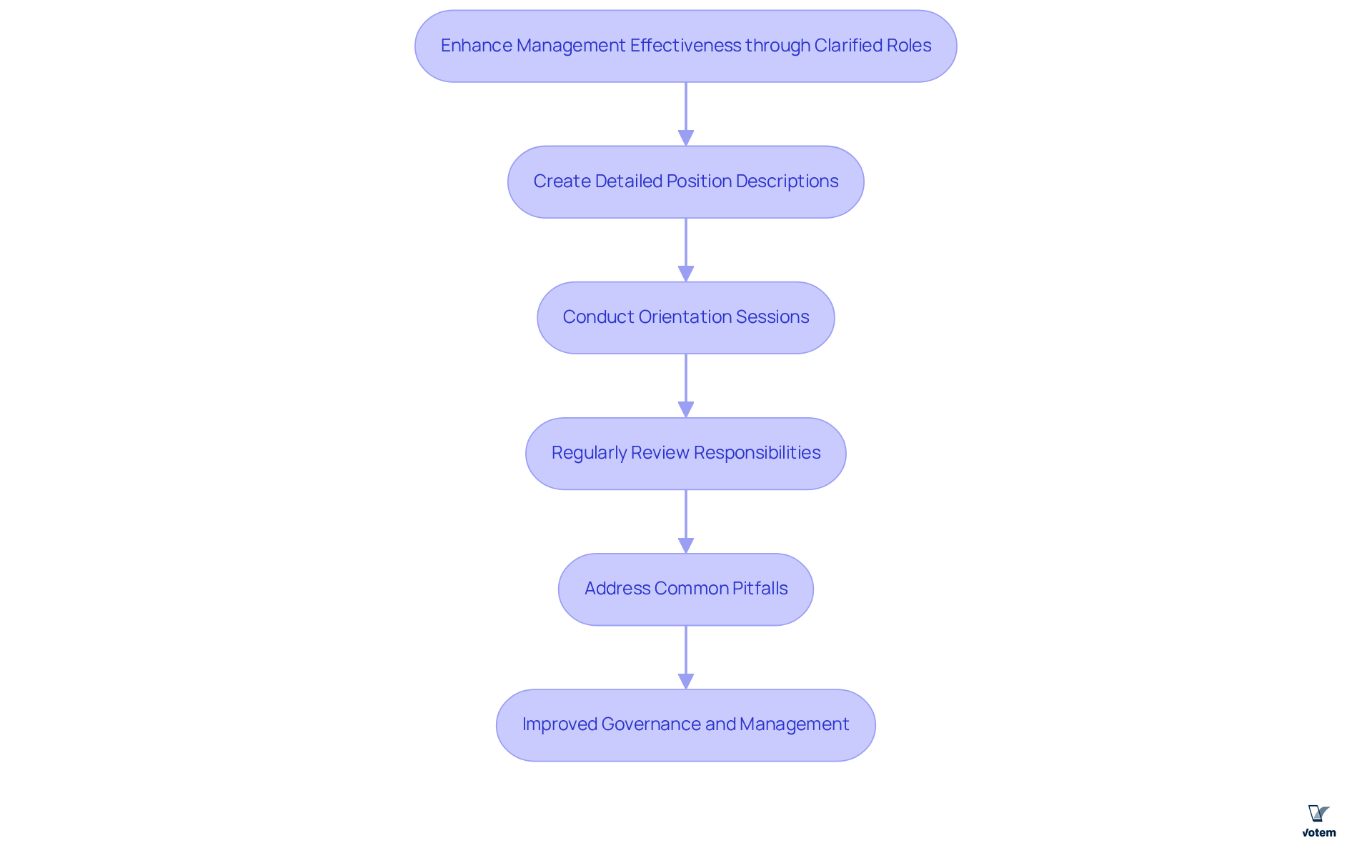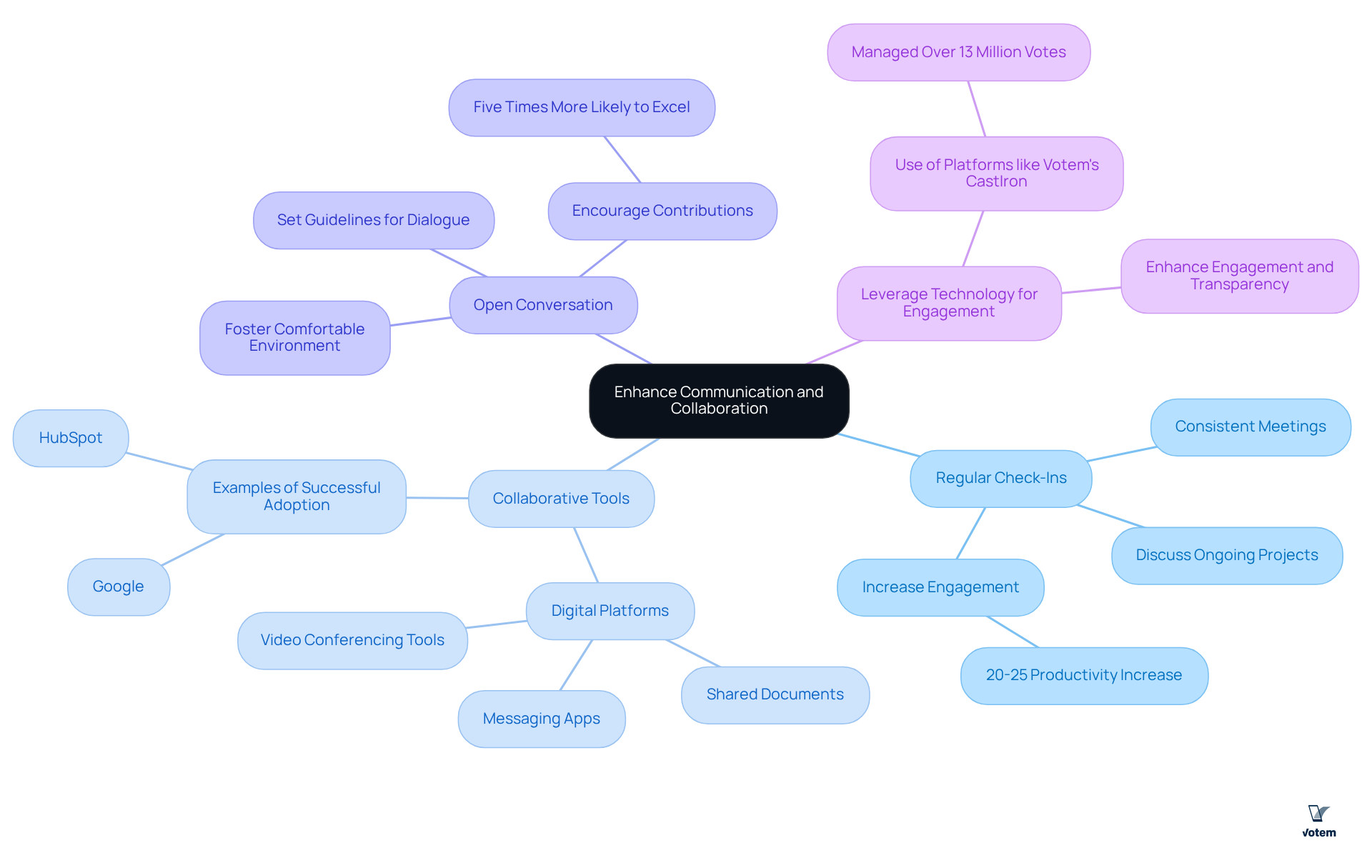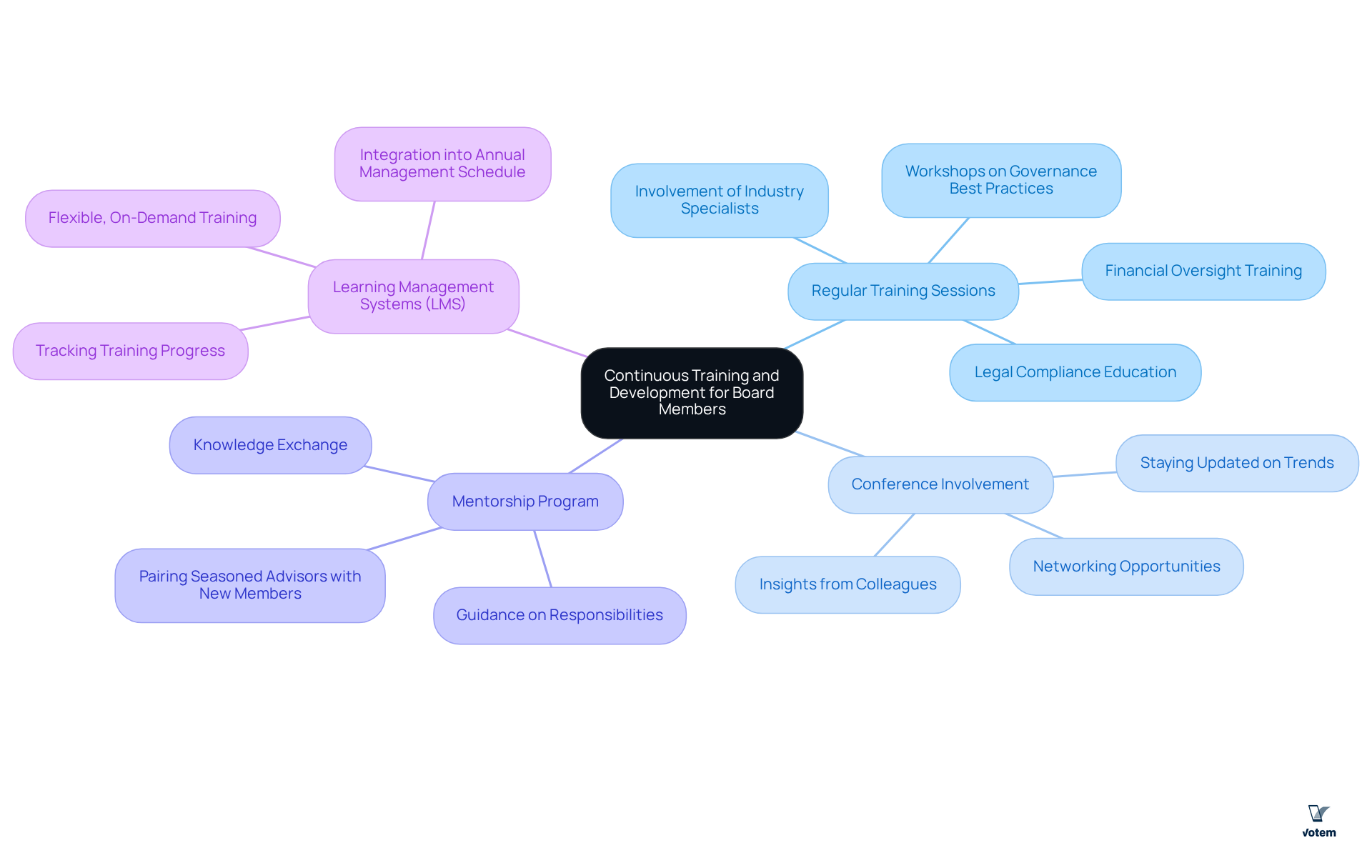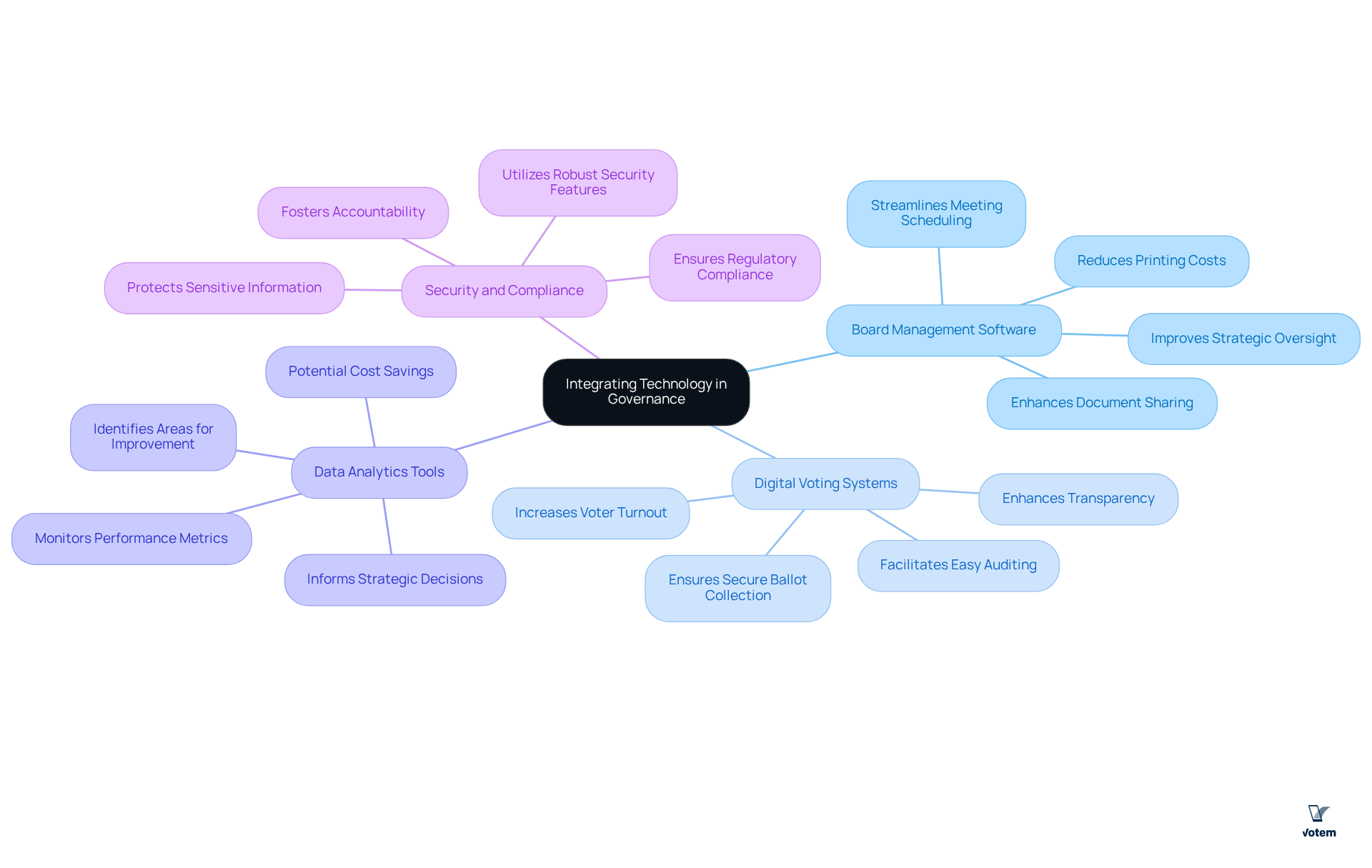Overview
This article underscores four essential practices that board members can implement to significantly enhance governance:
- Clarifying roles and responsibilities
- Improving communication and collaboration
- Implementing continuous training and development
- Effectively utilizing technology
Each practice is bolstered by specific strategies and examples. For instance, detailed position descriptions are crucial for ensuring clarity, while regular training sessions foster ongoing education. Moreover, the adoption of board management software can streamline processes, ultimately contributing to heightened organizational effectiveness and accountability. By embracing these practices, board members can navigate the complexities of governance with greater confidence and efficacy.
Introduction
Effective governance serves as the backbone of any successful organization. However, many boards encounter significant challenges in achieving the clarity and collaboration essential for optimal performance. By implementing key practices that clearly define roles, enhance communication, and leverage technology, board members can markedly improve their governance capabilities. Yet, the pressing question remains: how can boards navigate common pitfalls to ensure that every member is both engaged and effective in their role? This article delves into four essential practices that can transform board governance into a powerhouse of organizational success.
Clarify Roles and Responsibilities of Board Members
To enhance management effectiveness, it is essential for to define for each committee participant. This can be accomplished through several key practices:
- Creating Detailed Position Descriptions: Each board member should possess a comprehensive written description of their role, delineating specific duties and expectations. This document must encompass critical elements such as authority, reporting structure, and required skills, and should be reviewed regularly to ensure its ongoing relevance. not only clarify expectations but also assist in recruiting suitable candidates by providing insight into the commitments involved. Notably, BoardEffect serves over 14,000 organizations across 48 nations, underscoring the widespread recognition of the importance of governance practices.
- Conducting Orientation Sessions: It is imperative that new board members engage in an orientation that encompasses their roles, the board’s overarching mission, and how their contributions integrate into the broader organizational framework. This foundational understanding fosters both engagement and alignment with the entity’s goals.
- Regularly Reviewing Responsibilities: and responsibilities are vital for adapting to any changes within the organization or its strategic direction. This practice aids in maintaining alignment and accountability among members of a board, ensuring that everyone remains aware of their contributions to the group’s effectiveness.
Highlighting the significance of distinct roles, the members of a board can substantially impact . When members of a board understand their unique duties, they can , thereby enhancing the overall effectiveness of the group. As noted by BoardSource, “Filling all roles and allocating responsibilities among the members of a board can ensure proper supervision and promote the entity’s efforts.” Furthermore, a case study on the functions and duties of nonprofit committee members illustrates how well-defined roles lead to improved management outcomes.
- Addressing : While establishing clear roles is crucial, organizations must be vigilant about common pitfalls, such as ambiguous descriptions or overlapping responsibilities, which can result in confusion and inefficiency. By proactively addressing these challenges, organizations can significantly enhance their governance practices.

Enhance Communication and Collaboration Among Board Members
To foster better communication and collaboration among , consider the following strategies:
- Establish Regular Check-Ins: Schedule consistent meetings to discuss ongoing projects, challenges, and successes. Regular check-ins not only keep everyone informed but also enhance engagement. Organizations that prioritize .
- Utilize Collaborative Tools: Implement digital platforms that facilitate communication, such as shared documents, messaging apps, and video conferencing tools. Companies like Google and HubSpot exemplify successful adoption of various tools, leading to improved decision-making processes and stronger team dynamics.
- where members of a board feel at ease expressing their ideas and concerns. By setting basic guidelines for respectful dialogue and actively seeking contributions from all participants, teamwork can significantly improve. Studies indicate that entities encouraging collaboration are five times more likely to excel at a high level.
- Leverage Technology for Engagement: Utilize tools like , which has successfully managed , demonstrating the effectiveness of technology in . Such platforms can enhance communication and ensure that all voices are acknowledged, promoting a culture of inclusivity and trust among participants.

Implement Continuous Training and Development Programs for Board Members
To ensure board members remain effective and informed, organizations must take decisive actions:
- Offer : It is essential to schedule workshops and seminars that focus on , , and legal compliance. By involving industry specialists or leveraging the expertise of advisors, organizations can significantly enhance the , ensuring that all participants are well-versed in their responsibilities.
- Promote Involvement in Conferences: Organizations should assist individuals in attending . Such opportunities empower participants to gain valuable insights from colleagues, share experiences, and stay abreast of the latest trends and challenges in governance.
- Create a : Establishing a mentorship initiative that pairs seasoned advisors with newer participants is crucial. This relationship fosters and provides guidance to members of a board on managing responsibilities, thereby promoting a culture of and support.
- Utilize : Implementing LMS is vital for effectively managing and tracking training for directors. This approach allows for flexible, on-demand training, ensuring continuous learning without infringing on valuable meeting time. By integrating training into the yearly management schedule, organizations can adapt to the evolving needs of their leadership teams and enhance overall efficiency.

Utilize Technology to Streamline Governance Processes
To effectively integrate technology into governance processes, organizations should consider several key strategies:
- : Implementing dedicated platforms can significantly streamline meeting scheduling, document sharing, and communication among board members. This not only saves time and minimizes the risk of miscommunication but also lowers printing and distribution expenses, enabling groups to concentrate on strategic oversight and long-term planning.
- : For groups that require participant voting, digital voting systems provide a secure and efficient approach for ballot collection and counting. , for instance, has successfully handled over 13 million votes and significantly for events like the National Radio Hall of Fame. These systems enhance accessibility and transparency, ensuring that all votes are accurately recorded and easily audited, which is crucial for maintaining trust in the electoral process.
- : Utilizing analytics tools allows organizations to monitor the performance metrics of members of a board, along with member engagement and adherence to regulatory standards. According to Harvard Business Review, improved management practices in the nonprofit sector could potentially free up $100 billion. This data-driven approach informs strategic decisions and highlights areas for improvement, ultimately enhancing the effectiveness of governance practices.
- : Utilizing technology that meets stringent security standards, such as end-to-end encryption and robust audit trails, is essential for protecting sensitive information. These features not only safeguard organizational data but also ensure compliance with regulatory requirements, fostering a culture of accountability and trust among stakeholders.

Conclusion
Enhancing governance within an organization is essential for its success and sustainability. By clarifying roles and responsibilities, fostering communication and collaboration, implementing continuous training, and leveraging technology, board members can significantly enhance their effectiveness. Each of these practices contributes to a well-functioning board that aligns with the organization’s mission and is capable of making informed decisions.
The article outlines four key practices:
- Defining distinct roles for board members to prevent overlap and confusion.
- Establishing regular communication channels to keep everyone engaged.
- Providing ongoing training to ensure members are equipped with the latest knowledge.
- Utilizing technology to streamline governance processes.
Each of these strategies plays a crucial role in promoting accountability, transparency, and efficiency within the board.
Ultimately, the commitment to enhancing governance practices transcends mere responsibility; it fosters a culture of collaboration and continuous improvement. Organizations prioritizing these practices are likely to experience increased engagement, improved decision-making, and stronger alignment with their strategic goals. By taking actionable steps toward effective governance, board members can lead their organizations to greater success and resilience in an ever-evolving landscape.
Frequently Asked Questions
Why is it important to clarify roles and responsibilities of board members?
Clarifying roles and responsibilities is essential for enhancing management effectiveness and ensuring that board members understand their unique duties, which allows them to focus on supervision rather than micromanagement.
What practices can help define distinct roles for board members?
Key practices include creating detailed position descriptions, conducting orientation sessions for new members, and regularly reviewing responsibilities to adapt to changes within the organization.
What should a comprehensive written position description for board members include?
A position description should include specific duties and expectations, authority, reporting structure, required skills, and it should be reviewed regularly to maintain its relevance.
How do orientation sessions benefit new board members?
Orientation sessions provide new members with an understanding of their roles, the board’s mission, and how their contributions fit into the broader organizational framework, fostering engagement and alignment with the entity’s goals.
Why is it necessary to regularly review board member responsibilities?
Regular reviews are vital for adapting to changes within the organization or its strategic direction, helping maintain alignment and accountability among board members.
What common pitfalls should organizations avoid when establishing roles for board members?
Organizations should avoid ambiguous descriptions and overlapping responsibilities, as these can lead to confusion and inefficiency in governance practices.
How do well-defined roles impact organizational effectiveness?
Well-defined roles allow board members to focus on their specific contributions, which enhances overall group effectiveness and promotes proper supervision within the organization.
List of Sources
- Clarify Roles and Responsibilities of Board Members
- Nonprofit Board Positions: Structure, Roles and Responsibilities | BoardEffect (https://boardeffect.com/blog/nonprofit-board-positions)
- Board Governance Best Practices for Modern Organizations (https://imd.org/blog/governance/guide-to-board-governance)
- Board Member Roles and Responsibilities | BoardSource (https://boardsource.org/fundamental-topics-of-nonprofit-board-service/roles-responsibilities)
- Board Roles and Responsibilities (https://councilofnonprofits.org/running-nonprofit/governance-leadership/board-roles-and-responsibilities)
- Enhance Communication and Collaboration Among Board Members
- 35 Quotes about Communication to Inspire Collaboration (https://vibe.us/blog/35-quotes-about-communication?srsltid=AfmBOoo0oWBNPJXAIha_UDFNL1ZPFUZ3bIpRzPnZYaOYYIkMLO0ZBMOA)
- Workplace Communication Statistics (2025) (https://pumble.com/learn/communication/communication-statistics)
- 50 Eye-Opening Statistics About Employee Communications (https://aiscreen.io/digital-signage-employee-communications/statistics-about-employee-communications)
- notta.ai (https://notta.ai/en/blog/workplace-communication-statistics)
- Here’s How To Improve Board Of Directors Communication (https://ibabs.com/en/board-management/improve-board-of-directors-communication)
- Implement Continuous Training and Development Programs for Board Members
- The importance of volunteer board governance training | BoardEffect (https://boardeffect.com/blog/importance-board-governance-training)
- Youth INC (https://youthinc-usa.org/news/maximize-your-impact-as-a-nonprofit-board-member)
- Praxonomy Blog | The Importance of Board Governance Training (https://praxonomy.com/blog/the-importance-of-board-governance-training)
- Effective Board Member Training Is Critical to Your Organization | Relias (https://relias.com/blog/effective-board-member-training-is-critical-to-your-organization)
- The Importance of Board Training and Education (https://nonprofitenthusiast.com/the-importance-of-board-training-and-education)
- Utilize Technology to Streamline Governance Processes
- Board Management Software: U.S. Executive Guide to Smarter Governance (https://boardcloud.us/news/posts/what-is-board-management-software-a-us-executives-guide-to-smarter-safer-governance-in-2025)
- How Technology is Reshaping Governance Frameworks and Practices (https://directors-institute.com/post/how-technology-is-reshaping-governance-frameworks-and-practices)
- Why Board Management Software is Essential for Modern Governance (https://boardpac.co/blogs/why-board-management-software-is-essential-for-modern-governance)
- How Governance Technology Can Increase Efficiency for Your Healthcare Board – BoardEffect (https://boardeffect.com/blog/how-governance-technology-can-increase-efficiency-for-your-healthcare-board)
- Digital transformation: the key to unlocking your board’s full potential – Governance Institute of Australia (https://governanceinstitute.com.au/news_media/digital-transformation-the-key-to-unlocking-your-boards-full-potential)

